Exploring Fiberglass Pool Coping and Decking Options
September 21, 2024When you choose a Barrier Reef Fiberglass Pool, you’re not just opting for a high-quality, durable pool—you’re also opening up a world of design possibilities to create a stunning backyard. And two key design elements that can significantly enhance both the aesthetics and functionality of your pool area are the pool coping and decking. Let's discuss the various options available for each and how each can transform your pool space.
Pool Coping
Coping is the material used to cap the pool shell wall, providing a smooth transition between the pool and the surrounding deck. Swimming pool coping serves many important purposes for your fiberglass pool. It helps protect the pool structure by being a protective cap for the pool’s edge, enhances safety by providing a rounded or smooth edge to reduce the risk of injury, and creates a clean and visually pleasing transition from the pool to the surrounding deck.
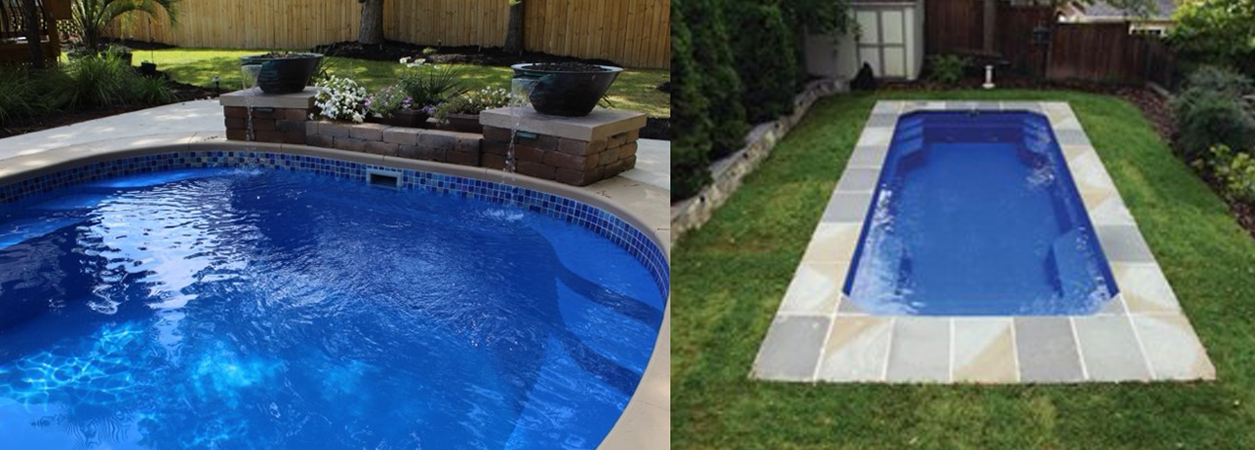
Left image: Coral Sea in Ocean Shimmer with cantilever coping and concrete decking
Right image: Grande in Ocean Shimmer with one piece stone coping & decking
When selecting from swimming pool coping options, make sure you think about your fiberglass pools’ shape, style, and color. For instance, a sleek, straight-edged coping works well with a modern rectangular pool, while a more rounded or natural stone coping suits a freeform pool. If you want to make the pool pop, use a contrasting color around it, or if you want a more seamless look use a complementary color. Choosing the best swimming pool tile and coping can be a complicated decision, though an important one. There are many options to consider when choosing the best way to put coping around a swimming pool. Also, think about the entire backyard. Ensure the coping style harmonizes with the surrounding landscape and hardscape features, such as patios, walkways, and garden areas.
Here are the most common types of materials used when installing coping for swimming pools such as a Barrier Reef Fiberglass Pool:
Cantilevered Concrete Coping
Cantilevered concrete coping involves pouring concrete around the edge of the fiberglass pool, creating a seamless, overhanging edge that extends slightly over the pool’s edge.
Benefits:
- - Provides a clean, modern look.
- - Can be customized with various finishes, colors, and textures (e.g., stamped or colored concrete).
- - Durable and low-maintenance.
Best For: Homeowners seeking a contemporary appearance with minimal maintenance.
Just like with driveways or patios, it's normal for concrete around your pool to settle over time, which can sometimes lead to minor cracks. This typically doesn't affect the integrity of your pool. But regular maintenance and timely repairs will keep everything looking great.
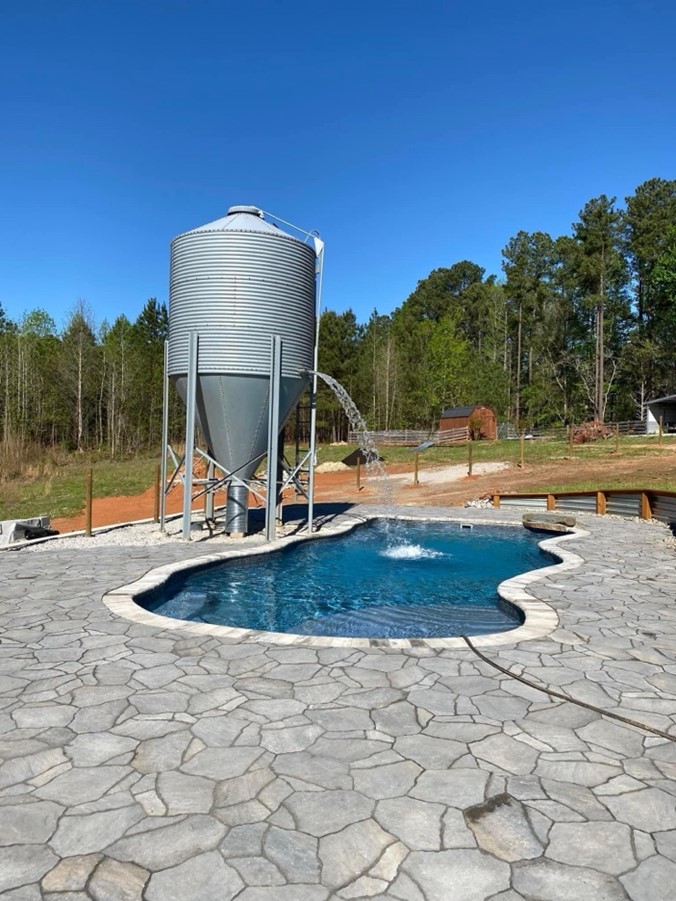
Billabong Cove in Evening Sky Shimmer with cantilevered coping to look like stone with stamped concrete
Paver Coping
Paver coping consists of individual paver stones, typically made from concrete, brick, or natural stone, installed around the pool's edge. The pavers can be flat or have a slight bullnose for a rounded edge.
Benefits:
- - Versatile in design with a wide range of colors, shapes, and patterns.
- - Easy to replace individual pavers if damaged.
- - Provides a slip-resistant surface.
Best For: Those looking for a customizable, classic look with easy maintenance.
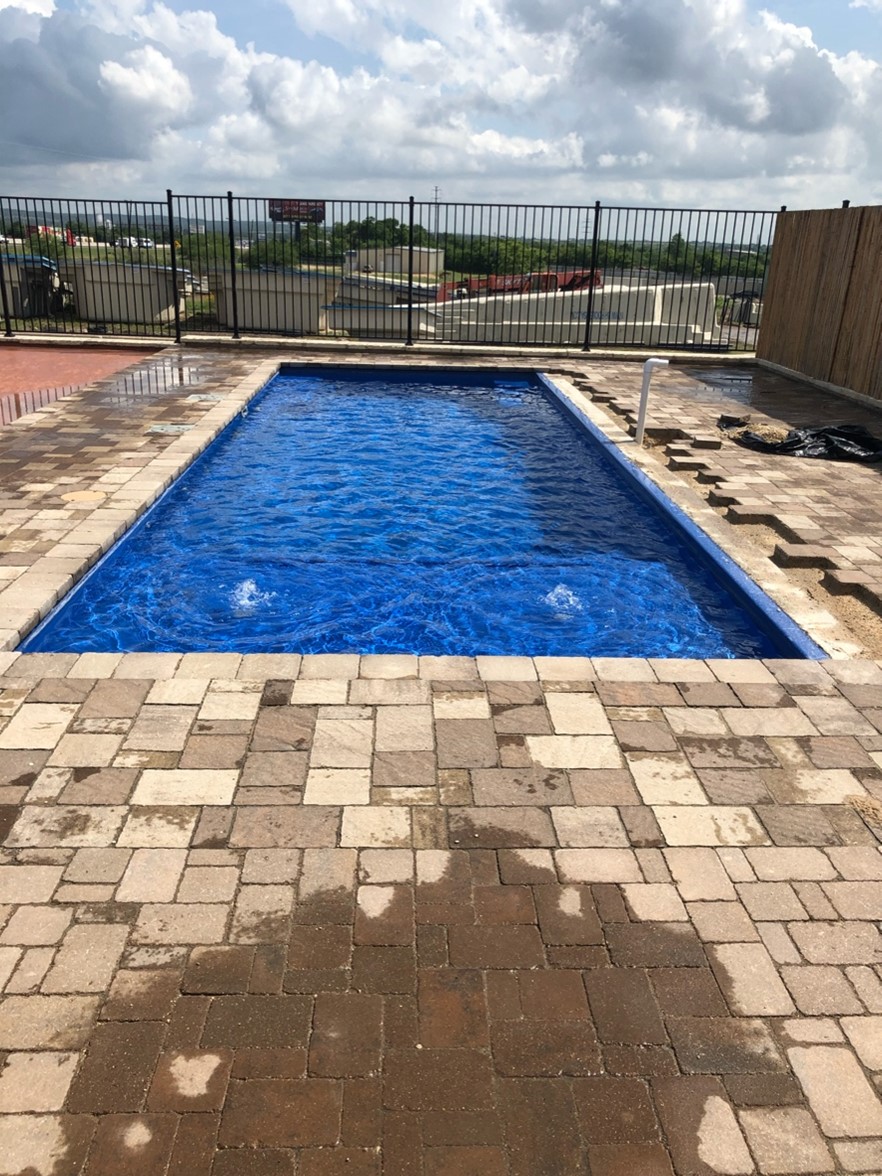
Outback Lounger in Ocean Shimmer with paver coping & decking
Natural Stone Coping
Natural stone coping uses materials like travertine, limestone, sandstone, or granite, cut to fit around the pool’s edge. The stone can have a variety of edge finishes, such as bullnose, tumbled, or chiseled.
Benefits:
- - Offers a luxurious, high-end appearance.
- - Natural variation in the stone adds unique character.
- - Stays cool underfoot, even in hot weather.
Best For: Homeowners wanting a sophisticated, natural look with the benefit of a cooler surface in sunny climates.
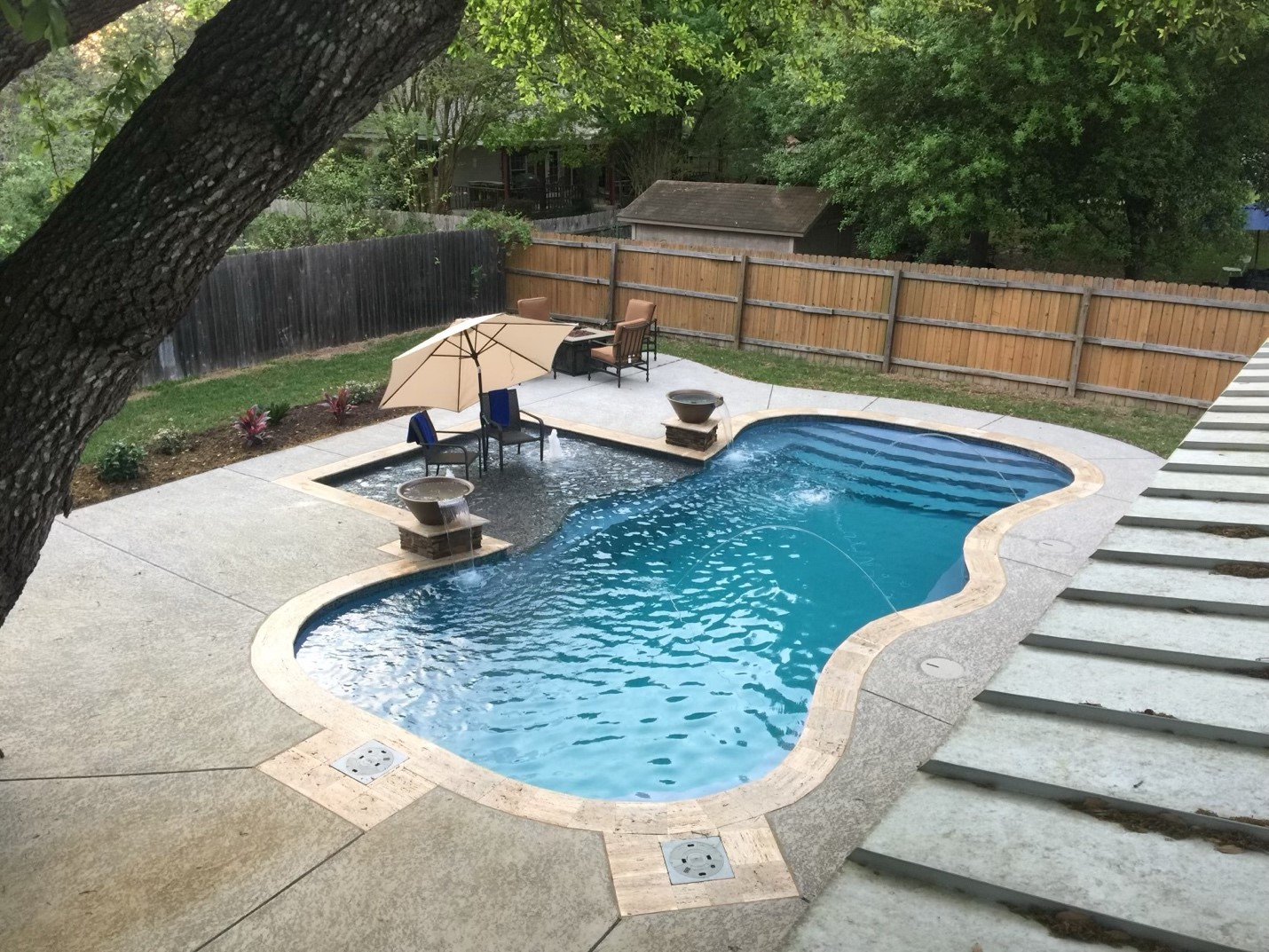
Coral Sea in Evening Sky Shimmer with travertine coping and concrete decking
Brick Coping
Brick coping involves using specially made bricks, often with a bullnose edge, installed around the pool’s perimeter. The bricks can be laid in various patterns for different visual effects.
Benefits:
- - Timeless, classic aesthetic.
- - Durable and slip-resistant.
- - Easy to match with other outdoor features like patios or walkways.
Best For: Traditional or rustic designs where warmth and durability are priorities.
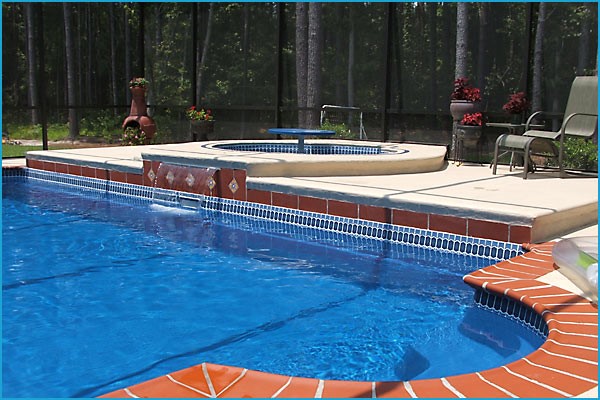
Milano in California Shimmer with brick coping and concrete decking
Travertine Coping
A specific type of natural stone coping, travertine is a form of limestone that is particularly popular for pool areas. It typically comes with a tumbled or bullnose finish.
Benefits:
- - Offers a luxurious look with a naturally non-slip surface.
- - Heat-resistant, staying cool underfoot.
- - Available in various earthy tones, adding elegance to the pool area.
Best For: Elegant, high-end pool designs in warm climates.
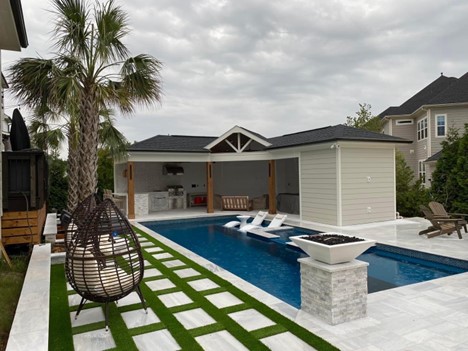
Sydney Harbour in Aquamarine Shimmer features travertine coping & decking
Fiberglass Pool Decking
The pool deck is where you’ll spend a lot of your time relaxing, entertaining, and enjoying your outdoor space. The right swimming pool deck can significantly enhance the overall look of your pool area, complementing the pool’s design and integrating with the surrounding landscape. The swimming pool deck area offers a space to place poolside furniture such as loungers, tables, chairs, and umbrellas.
Here are some of the best swimming pool decking ideas for your Barrier Reef Fiberglass Pool:
Concrete Pool Decking
Poured Concrete: This is a popular swimming pool deck option for fiberglass pools due to its versatility and durability. Poured concrete can be customized with various finishes, colors, and textures, including broom-finished, stamped, or stained concrete. It provides a clean, seamless look that works well with the smooth lines of a fiberglass pool.
Stamped Concrete: Offers the look of more expensive materials like stone, brick, or wood but at a lower cost. It can be designed to mimic various patterns and textures, adding a decorative element to the pool area.
Exposed Aggregate: This type of concrete has small stones or pebbles exposed on the surface, creating a textured, non-slip finish that is both attractive and functional.
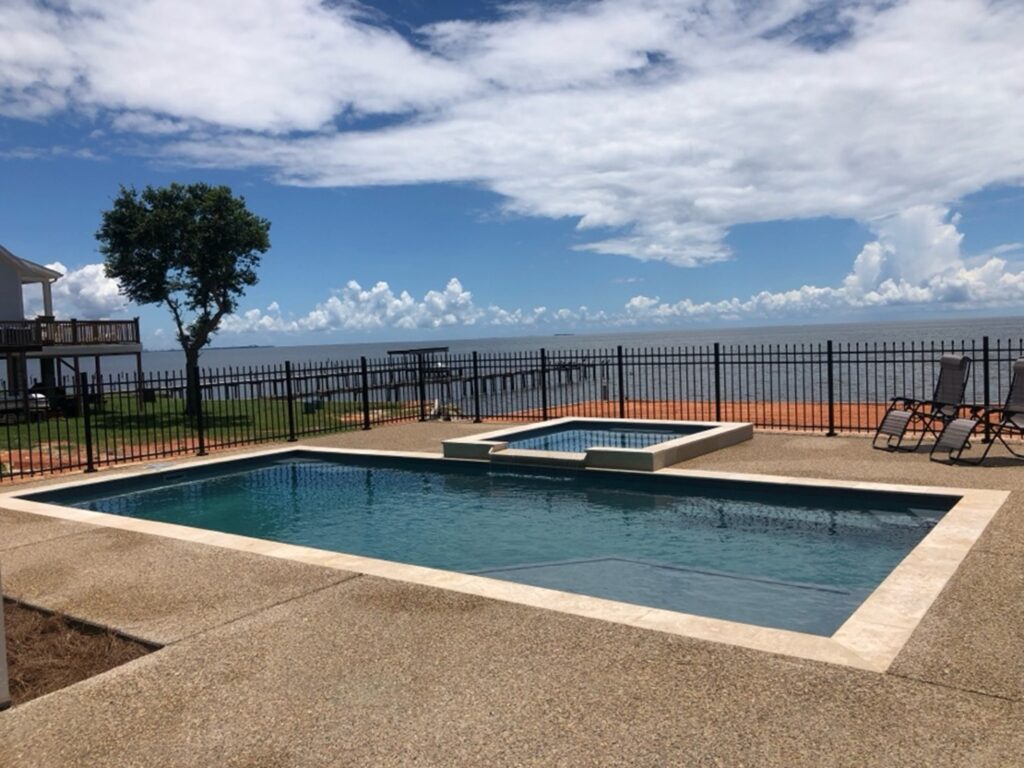
Whitsunday Lounger in Aquamarine Shimmer with stone coping and exposed aggregate
Wood Pool Decking
Ipe (Brazilian Walnut): Ipe is a hardwood known for its incredible durability and natural resistance to water, insects, and rot. It’s an attractive option that can last for decades with proper maintenance, though it may require periodic sealing and staining.
Cedar or Redwood: These softer woods are naturally resistant to decay and offer a warm, classic look. However, they require regular maintenance, including sealing and staining, to protect against moisture and UV damage.
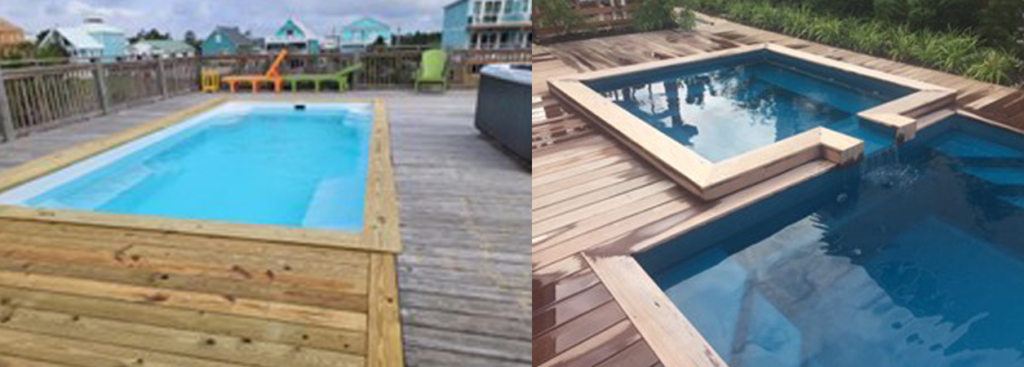
Left: Outback in Arctic Shimmer with wood coping & decking
Right: Cube Spa and Outback in Aquamarine Shimmer with wood coping & decking
Paver Pool Decking
Concrete Pavers: These are a flexible and durable option for swimming pool decks suitable for use with fiberglass pools. Pavers come in various shapes, colors, and patterns, allowing for creative designs. They are easy to replace individually if damaged, making them a practical choice.
Travertine Pavers: Travertine is a natural stone known for its elegant appearance and cool surface underfoot. It’s slip-resistant and heat-resistant, making it ideal for pool decks. Travertine pavers are available in various colors and finishes, from smooth to tumbled.
Brick Pavers: For a more traditional or rustic look, brick pavers are an excellent choice. They are durable, slip-resistant, and add warmth to the pool area.
Natural Stone Pool Decking
Travertine: As mentioned above, travertine is a top choice for natural stone decking due to its beauty and practicality. Its ability to stay cool in the sun and its textured surface make it both functional and luxurious.
Limestone: Another natural stone option, limestone offers a soft, natural appearance that pairs well with the smooth surface of fiberglass pools. It’s durable and can withstand weathering, but it may require sealing.
Sandstone: Sandstone provides a natural, earthy look and is available in a range of warm tones. It’s a durable, non-slip option but may need regular maintenance to preserve its appearance.
Flagstone: Flagstone consists of flat, irregularly shaped stones like sandstone, limestone, slate, or bluestone. These stones are laid out can create a distinctive, rustic, and natural appearance.
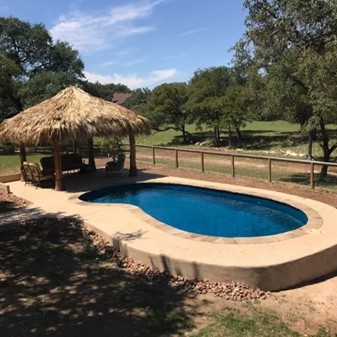
Oyster in Aquamarine Shimmer with flagstone coping & concrete textured decking
Composite Pool Decking
Wood-Plastic Composites: Composite decking is made from a blend of wood fibers and plastic, offering the appearance of wood without the high maintenance. It’s resistant to splintering, fading, and staining, making it a low-maintenance and long-lasting option for pool decking.
Slip-Resistant: Many composite decking products are designed with a slip-resistant texture, providing safety around the pool area. As a reminder, water is not slip-resistant, so please always be careful.
Tile Pool Decking
Porcelain or Ceramic Tile: Tiles can create a sleek, modern look around a fiberglass pool. They are available in various styles, from natural stone looks to vibrant colors and patterns. Choose tiles with a textured, slip-resistant finish to enhance safety.
Choosing the Right Combination of Pool Coping and Decking
How do you choose the right combination of pool coping and decking? Here are some things to keep in mind to have a harmonious design.
Consider the overall look you want to achieve. Do you prefer a contemporary, traditional, or natural look? Your coping and decking should complement the style of your home and outdoor living area.
Choose materials that work well together. For example, if you select travertine for coping, you might choose matching travertine pavers or complementary materials like concrete or wood for the decking.
Choose materials that fit your climate. In areas with extreme temperatures, freeze-thaw cycles, or high humidity, some materials may perform better than others.
Consider the maintenance of the materials you select. For example, natural stone may require periodic sealing, while composite decking is generally low maintenance. Consider how much time and effort you’re willing to invest in upkeep.
Are you putting in a saltwater pool? Select materials that are resistant to salt corrosion, such as certain types of natural stone or specially treated concrete.
Obtain samples of the coping and decking materials. Lay them out together to see how they look in your actual outdoor environment.
Final Thoughts
When you work with an authorized Barrier Reef Fiberglass Pool installer, they can help you pick the perfect pool, coping and decking for your space. Ready to get started? Talk to a pro about creating your dream backyard or reach out to us on our social media channels listed below.